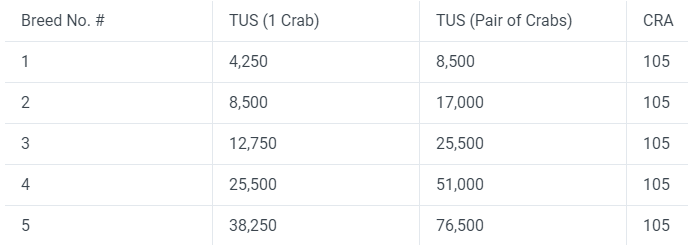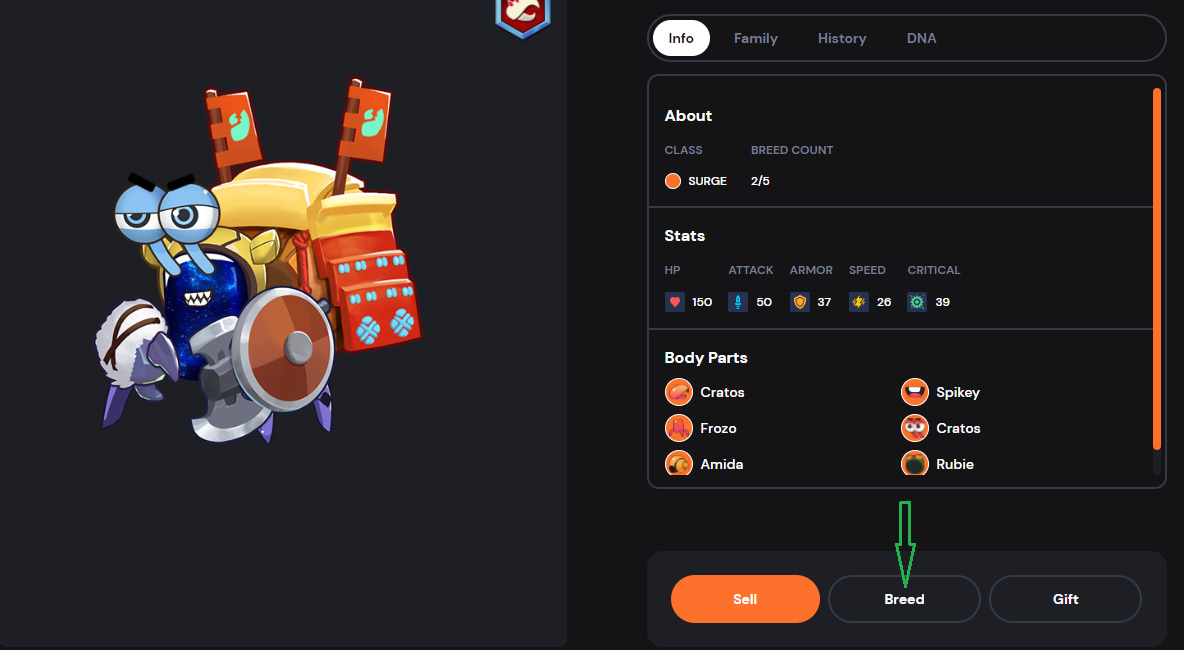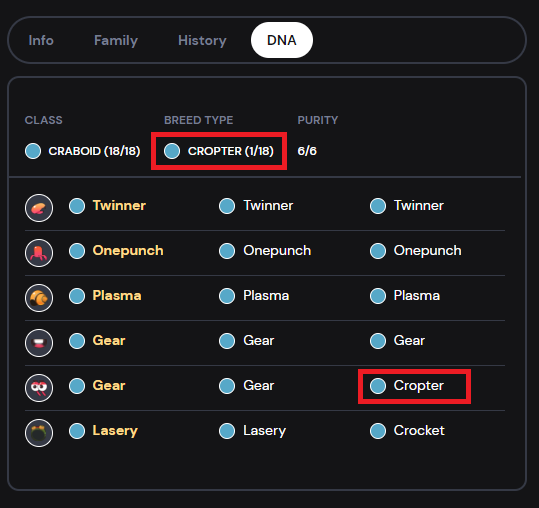Crabada Breeding Guide
Introduction
In the game of Crabada, Breeding is an important part of the game and its economy. Every new crab that comes into the ecosystem is the result of breeding two existing crabs together. For new players to join the game as well as for current players to expand their teams, new crabs need to be bred constantly.
The @PlayCrabada team has put together an intricate system of tokenomics that not only allows healthy, gradual inflation of its $TUS token and its crab population, but also rewards breedors adequately for their time and investment in the game. We have a game that’s on a solid foundation tokenomically speaking, as well as a team that’s constantly finding new ways to give utility to its $CRA, $TUS and $CRAM tokens.
In this guide, I will give you the knowledge you need to understand how breeding works, the numbers behind it, as well as the strategies and risks involved. Armed with this information, you should be able to decide for yourself if breeding is for you and how you want to incorporate it as part of your Crabada strategy.
Let’s get started.
Why Breed?
Breeding is a valid way to generate returns in Crabada, as well as a very cost effective way to add crabs and expand your teams, albeit with a delay. Besides that, as a breedor who breeds and sell crabs on the marketplace, you are helping to propagate the crab population for future Crabadians. And lastly, it’s fun! I find breeding to be a lot more strategic than going through the motions of mining and looting in current idle-game. You can set goals such as establishing self-sustaining breeding pools for different classes, purify a crab’s breed count towards 18/18, etc. and strive towards completing them. Every egg you hatch is also like a lottery ticket. Still looking to hatch that elusive legendary crab myself!
Pros and Cons
Breeding has advantages and tradeoffs compared to other ways of generating returns in Crabada. As a Breedooor who breeds and sells off bred parents for profit, consider the following + and -’s:
Pros:
Higher return on capital vs Mining and Tavern in general, though not as high as looting.
Less effort/clicking/time required than Mining/Looting, as eggs only hatch after 5 days while Mining is every 4 hours and Looting every 1 hour.
Chance of legendary with every egg hatched.
Very scalable and easy to compound returns.
Cons:
Very high capital requirements compared to other income generating methods.
Variable returns as market price of crabs fluctuate from day to day.
Less liquid portfolio if you own a large # of eggs.
Maximizing returns requires extensive knowledge of marketplace and meticulous planning.
With these in mind, let’s look at the mechanics behind breeding.
Basic Mechanics
Each crab in the game can be used to breed up to 5 times. We typically refer to breed count = 0 crabs as “virgins” since they haven’t been used to breed yet. We will call crabs that have been used to breed 2 or more times “bred” crabs or parents.
To breed a new crab, you need 2 crabs that can still breed (So that means breed count 0 to 4) and the necessary TUS and CRA tokens. It’s important to know that breeding cost varies depending on the breed count of the 2 crabs used. You add the breeding costs from each of the two crabs to get the total cost for breeding. Refer to the following table for breeding costs:
So for example, if you breed two virgin crabs (breed count = 0) together, the cost will be 8500 TUS and 105 CRA, since it will be breed no. 1 for both of the parent crabs. If you breed 2 crabs both with breed count = 2 (commonly known as getting the 3rd breed/egg), the cost will be 12750 + 12750 = 25500 TUS and 105 CRA. In rare cases, you will breed 2 crabs with different breed counts: if you breed a breed count 2 crab with a breed count 3 crab, the cost will be 12750 + 25500 = 38250 TUS and 105 CRA.
To breed, the crabs need to be in your marketplace inventory, not in game. Navigate to the marketplace page of one of the two crabs you wish to breed with, select “Breed” and its mate, confirm the transaction, and you will receive an egg.
Sometimes the breeding screen can get stuck with the swirling circle not going away. No need to panic, just refresh the page. You should see an egg in your inventory and the breed count of your parent crabs updated, as long as the transaction went through.
Note that after breeding, the parent crabs can immediately be sold or transferred back to the game and be put to work again. Each egg will take exactly 5 days or 120 hours to hatch. When that time comes, navigate to the marketplace page of the matured egg, click “Morph” and you will see your egg transform into an adult crab with breed count 0! Also, newborn crabs can be immediately used to breed again and create more offspring.
The only restriction to breeding is that a crab cannot breed with its siblings or its parents. For this reason, if you’re buying virgin crabs or eggs with the intention of breeding them, always check its “Family” tab and make sure you’re not buying siblings. Crabs with consecutive ID #’s have a high chance to be siblings.
Genes
A crab has 18 genes(Alleles) that make up its genetic pool. There’s a set of 3 genes ( 1 Dominant(D) and 2 Recessive(R1, R2) ) for each of the 6 body parts (Pincer, Body, Shell, Mouth, Eyes and Horn). Only the dominant gene (D) is expressed visually in the crab and is used to determine its stats and abilities. There are currently 8 classes of crabs and each class has 8 different genes/breeds. The following is a list of classes and breed types. More info can be found in the Crabadex page in the Crabada Whitepaper.
Surge(Tank): Emeraldo, Rubie, Amida, Cratos, Crazor, Spikey(Ivar), Vocrano, Frozo.
Bulk(Tank): Cragma, Cropion, Chief, Rocco, C-Rex, Crava, Crazurite, Charoite.
Gem(Tank): Croyo, Magnifiso, Earl Cray, Cranet, Cramethyst, Pearlio, Lapidari, Paraiba.
Prime(Damage): Avalanche, Bitcoin, Ether, Near, Cardano, Fantom, Solana, Binance(CZ).
Craboid(Damage): Gear, Redeye, Lasery, Plasma, Cropter, Onepunch, Twinner, Crocket.
Ruined(Damage): Skul, Deadeye, Crauldron, Pharaoh(Cramun-Ra), Crailer, Cranosis, Cragon, Crombie.
Sunken(Support): Craken, Staro, Crele, Crucket, Crotopus, Creasure, Crobster, Cralmon.
Organic(Support): Crawberry, Celon, Cranana, Natura, Eva, Adam, Bulbie, Freshie.
Important: As new information about Battle Game gradually rolls out, it has been confirmed that a crab’s Pincer and Eyes body parts will determine its abilities. Check the Crabadex for details.
When a crab hatches from its egg, its genes are determined using the parents’ genes. For each body part, 6 genes (3 from each parent, D, R1 and R2) are taken into consideration for the calculation:

Adding up the 6 genes, (33.33% + 11.11% + 5.56%) * 2, we get 100%. These same %’s are used 3 times for each of the new D, R1 and R2 genes for that particular body part. oxSaturn’s breeding tool is fantastic for looking up gene probabilities.
The class of the new crab is determined by its parents’ class with 50% equal weighting. So if you breed a Sunken with a Prime, you will get a Prime 50% of the time, and a Sunken the other 50% of the time. The same is true for the Breed Type of the new crab.
A crab will get bonus stats if the crab’s body parts’ class matches the class of the crab itself. For example, if a Prime crab has 5 Prime body parts (meaning the dominant gene is of a Prime breed type), and 1 non-Prime body part, it will get a 10% bonus to all its stats. Refer to the table below:

These bonus stats are the reason why most of the crabs currently in the game ecosystem and being born are “pure” crabs, meaning a crab with all 6 body parts matching its class. Pure crabs have the highest possible stats for a crab of its class, so they are the most competitive in current idle-game modes, mining and looting. This may change in the future. In the upcoming Battle Game, it might be worth it to breed different classes of crabs together to obtain specific combination of skills and abilities. The team might introduce mutations to inject variety in the breeding pool. For now though, “pure” breeding is the most common form of breeding, meaning you always breed 2 crabs of the same class, each with all 18 genes also of the same class. This ensures that the resulting children will be 18/18 crabs of that class.
There is a tiny chance (0.07%) that a body part of a new crab turn out to be a legendary part. When these legend parts appear, they have an equal chance to be from each of the 8 Crabada classes. If the legend part matches the crab’s class (1/8 chance), total stats of the crab will be increased by 10%. Otherwise the increase will be 5%. These stat bonuses can make legendary crabs very valuable, especially if they can increase the Battle Point total of the crab to be higher than the current max of 237 from a normal pure crab (Surge or Bulk). These crabs are typically put into the Tavern for rent at a high fee, or used by the owners themselves as reinforcements when mining to surprise their looters and get upset wins. Legend parts cannot be passed down to the next generation with breeding, so a crab with a legendary part is currently just like any other crab when used for breeding. You can take a look at the cool looking legendary crabs and their parts here.
Returns Calculation
For the sake of simplicity, I will base these calculations on the assumption that each virgin will be bred at least twice, since that’s the baseline to be able to keep your breeding operations going. 2 virgins bred together 2 times = 2 new virgins in 5 days. Think of the 3rd breed as an optional investment that can either expand your breeding operations or be sold off for profit when it hatches. As the cost of breeding a third time is 25500 TUS + 105 CRA, or roughly 26500 TUS when converted, and taking into account marketplace fees of 3.85% for selling, breeding a third time and selling the resulting virgin is only profitable when said virgin can be sold for >27500 TUS.
The most important variable used to estimate breeding returns is the price you can sell bred parents for. The average cost of the first two breeds is (8500 + 17000) / 2 = 12750 TUS and 105 CRA. With 1 CRA = 10 TUS, we can simplify that number to 13750 TUS. Taking into account marketplace fees, this means that as long as we can sell the 2 parents for > 14300 TUS, breeding and selling parents as a strategy is profitable.
The capital required to breed has 2 parts: cost of the virgin crab + cost of breeding the egg. Let’s ignore the fact that we need 2 crabs to breed and sibling-breeding is prohibited for now and focus on return per crab. For example, let’s say you acquire a virgin crab for 30000 TUS, breed an egg for an average cost of 13750 TUS, and manage to sell the bred parent for 17500 TUS. You will be making a return of 17500 * 0.9615 - 13750 = 3076.25 TUS every 5 days. From an investment perspective, your initial is cost of the virgin + cost of breeding next egg. Using this model, we arrive at a return over 5 days of 3076.25 / (30000 + 13750) * 100% = 7.03% or 1.41% daily with these variables.
Going further with the same assumptions, we arrive at the following table of breeding daily returns % numbers, with the average cost of breeding constant at 13750 TUS, and variable bred parent and virgin costs:
In practice, return numbers could be higher, if instead of holding the proceeds from parent sales for the whole 5 days, you use them to bootstrap more breeding. You could also use the bred parents in your teams for x / 5 days before selling them to raise funds for the next breeding round. Be aware that doing so could have a negative effect on your capital liquidity and might have you scrambling for funds come breeding day.
If you can make a profit by breeding 3 times and selling the virgin after 5 days, your returns will be higher still. Though the merit of doing so isn’t clear, since the third breed is expensive therefore your average return % per breed/egg will be lower. It will also negatively impact your liquidity by a lot.
Getting Started
Now let’s talk about how to start a breeding operation, practically speaking. The minimum starting requirement to start a breeding cycle, so to speak, is the cost of buying 2 virgins and breeding them 2 times each to get 2 eggs for the next cycle. Using numbers from our previous example, this comes to 30000 * 2 + 13750 * 2 = 87500 TUS. Selling the parents for 17500 TUS yields a total of 6152.5 TUS profit every 5 days. We have a problem though, as siblings can’t breed together. So when our 2 eggs hatch, we need to sell one of the virgins and buy a different one, hopefully for the same price. Assuming we are able to do so, a marketplace fee of 30000*3.85% = 1155 TUS will need to be substracted from our profits every 5 days. This decreases our returns by 18.77%.
To avoid this cost and the hassle of having to sell and repurchase a virgin crab every 5 days, we can resort to what is commonly known as ABC or ABCD breeding strategy:
ABC Strategy: You have A and B breeding together to make 2 eggs, with C on standby. When the eggs hatch (AB-1 and AB-2), you breed one of them with C twice (the new AB crabs) and leave the other one on standby (the new C crab). Continue indefinitely.
ABCD Strategy: You have 2 breeding pairs, AB and CD, that makes 4 eggs by breeding 2 times each. When they hatch, you cross breed the new virgins (AB-1 with CD-1 and AB-2 with CD-2, OR AB-1 with CD-2 and AB-2 with CD-1). After 5 days you will have 2 new pairs of sibling eggs and can repeat indefinitely.
Out of the 2 strategies, ABCD is strictly superior besides the fact that more capital is required. This is because in ABCD you use all your virgins to breed every round but in ABC, you always have 1 virgin on standby and not generating returns.
In fact, I can convincingly argue that AB and swap parents strategy is strictly superior to ABC strategy as well. Consider the following return calculations over 5 days for each strategy:
AB and swap: (6152.5 - 1155) / (30000 * 2 + 13750 * 2) = 5.71%
ABC: 6152.5 / (30000 * 3 + 13750 * 2) = 5.24%
ABCD: 6152.5 * 2 / (30000 * 4 + 13750 * 4) = 7.03%
AB and swap strategy has better returns with a lower capital requirement. The only upside for ABC is that you have more control over your gene pool as you’re not injecting new genes into your breeding all the time. Regardless, you want to upgrade to ABCD strategy ASAP as it has both better returns and better gene pool control.
Startup costs of the 3 strategies:
AB: 30000 * 2 + 13750 * 2 = 87500 TUS
ABC: 30000 * 3 + 13750 * 2 = 117500 TUS
ABCD: 30000 * 4 + 13750 * 4 = 175000 TUS
Expanding
As you operate your ABCD breeding operation and accumulate profits, you can start to think about expanding it. If you’re expanding within the same class, the easiest way to do so would be to breed your ABCD pairs 3 times instead of 2, and ending up with 2 sets of 3 virgin siblings in 5 days. You will then cross breed them as 3 pairs. When the next 3 sets of 2 virgin siblings hatch (AB, CD, EF), you can cross breed them and continue indefinitely: AB1 with CD1, AB2 with EF1, CD2 with EF2.
Alternatively, you can buy virgins from the marketplace and incorporate them into your existing breeding pool. The advantage of doing so is being able to add new genes to your pool. With the pincer and eyes body parts confirmed to determine a crab’s abilities, adding genes to your breeding pool can be key to increase your profitability.
To expand to a different class that you’re not currently breeding, you will need to start from AB or ABCD again from scratch. Be on the lookout for suitable breeding crabs and don’t hesitate to pull the trigger when the price is right.
Should I breed the 3rd time?
Below is an excerpt of what I shared in the Crab Cartel Discord group:
As there are a lot of moving factors here, I typically decide whether to breed 2 or 3 times right after my eggs hatch. An additional factor to consider is if you’re trying to purify for breed count/genes. It is then almost mandatory to breed 3 times to preserve/propagate the desired genes.
Purification
A popular breeding focus is to raise a crab’s breed count over generations or “purify” a breeding pool. A crab’s breed count is shown in its DNA page:
As this Craboid has 1 Cropter gene out of 18 genes and is of the Cropter breed type, it is shown as having Cropter (1/18). Though details are not confirmed, it is reasonable to assume that a higher breed count will have some kind of benefit in the future. If not, why is it shown there in the first place? The market generally agrees with this, as higher breed count crabs can command hefty premiums.
It is potentially very profitable to purify your breeding pool, but it’s generally an activity for bigger breedors / whales only. It takes a big breeding pool of the same breed type (minimum 6-8 virgins in my opinion) as well as constant injection of new virgins into your breeding pool that has genes you’re missing. You’re also required to 3 breed your best virgins each round and sell off your worst outcomes in terms of gene manifestation. This is a lengthy and costly endeavor. It can however pay off handsomely if you can reproduce 18/18 breed count crabs, or “genesis clones”. One example:
Non-Pure Breeding
As the prices of bred non-pure crabs or “mutts” on the marketplace are generally lower than their pure counterparts, it is currently not very profitable to pursue a mutt breeding strategy. This is why you see a lot of breed count 1 non-pure crabs for sale on the marketplace, since the second breed isn’t profitable enough to be worth it. Things could change quickly however, if hybrid crabs are very desirable in the upcoming Battle Game.
Tips and Tricks
Buying Eggs instead of Virgins to start off your breeding operation can reduce your startup cost. Be sure to buy only 18/18 pure eggs if you’re looking to breed pures. All egg results from this tool by @Gylve are pures.
Use Crabada Tracker to make your inventory management 10x easier when breeding. There are many many advantages to doing so, refer to my Community Resources Guide where I covered the tool in detail.
Plan ahead with your TUS and CRA and try to breed again as soon as your eggs hatch. Any time virgin crabs are sitting around in your inventory is time spent not generating breeding returns. This is why I’m very opposed to using virgin crabs in teams as you’re just tying up extra capital and getting less returns.
If you’re mostly a breedor and not generating enough CRA with teams to cover your breeding costs, you will need to buy CRA with TUS from DEX’s. Bookmark this Dexscreener page and try to buy the lows on the pair. You will get more CRA for your TUS on average over time. Make sure to click “Switch to price in TUS” on the chart.
As your breeding operation grows, try to distribute your breeding activity over different days in a 5-day window. This way you will have a more stable income flow and less liquidity issues.
As you get more familiar with the marketplace and its up and down cycles, you can aim to sell only when crab prices are high. In the mean time you can form temporary teams with your bred parents or put them into the tavern for extra income. It takes some practice and knowledge of the market but can be the key to maximizing your returns.
Breeding and keeping bred parents to form permanent teams is the cheapest way to acquire teams. Calculate your average 5 day return with your current # of teams (again use Crabada Tracker) and see if you can keep some of the parents each cycle. Every ~13750 TUS generated over 5 days means you can keep an additional bred crab instead of selling.
Conclusion
It can seem daunting at first to become a breedor, but it’s a very rewarding endeavor to pursue. With the upcoming Battle game release in May, breedoors will be sorely needed. The future breeding landscape will look nothing like what we have today. So get familiar with breeding now and you may be able to capitalize on future opportunities as they present themselves.
I hope you enjoyed this detailed look into the art of breeding. It has certainly been enjoyable for me to write it! Find me on Twitter @KingSkyWing and shoutout to the best Crabada community discord, Crab Cartel! Feel free to join and ask me anything there.
Until next time,
#snibsnib!
SkyWing











